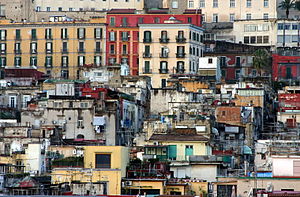Quartieri Spagnoli
The Quartieri Spagnoli (German: Spanish Quarter ) are a district in the southern Italian port city of Naples . You are in the second administrative unit ( Municipalità II ) and within this in the district ( Quartiere ) Montecalvario . Although their name suggests, they are not a separate district.
The Quartieri Spagnoli are part of the historic center of Naples. Today most of the houses are multi-story, the streets are very narrow and rarely wider than five meters.
Their name comes from the fact that in the early modern period they were mainly used as quarters for the Spanish soldiers of the ruling Spanish viceroys .
location
The Quartieri Spagnoli are located directly on one of the main shopping streets in Naples, on Via Toledo . On the other side of the Quartieri begins the Vomero hill , on which there is a monastery and the fortress of Sant'Elmo . On this side of the district, which is bounded by the Vomero, you will find numerous dead ends, only a few streets lead uphill.
Due to the dead ends, the narrowness of the streets and the notoriety of the district, there is relatively little through traffic in large parts of the Quartieri - although they are very centrally located.
Population and life
The Quartieri are 0.125 square kilometers and extremely densely populated. The population structure is heterogeneous, it consists of long-established Neapolitans as well as immigrants. The Quartieri Spagnoli are considered to be a rather poor and disreputable neighborhood, but since the 2000s there have been minor signs of gentrification . Higher earners, intellectuals, artists and students live in attic apartments and on the outskirts of the district. Aside from the dense housing development, there are many shops, workshops, a few public institutions and numerous churches.
Even today, the ground floor apartments (the Bassi ) that are widespread in Naples characterize the image of the quarter. These are apartments with living rooms or kitchens separated from traffic by a simple door.
history
The Quartieri Spagnoli were built during the tenure (1532 to 1553) of the Spanish viceroy Pedro Álvarez de Toledo between the fortress of Sant'Elmo, located on the Vomero hill, and the city that was then surrounded by a wall. To do this, he had part of the city walls demolished and replaced them at this point with the Via Toledo, which still exists today . The newly built quarter was laid out in a grid shape and consisted of two-story buildings. One reason for the city expansion was that the tenants of the new buildings could now - for money - billet Spanish soldiers of the viceroy (hence the name Quartieri Spagnoli).
In the course of time, the houses were usually increased by a few storeys due to the need for living space, and partition walls and even intermediate floors were added to get more rooms. These often small and nested structures were then often connected by additional staircases.
Social problems
The quarters are considered poor and disreputable. As in other areas of the city, the Camorra should also be active here . One of the main problems is the high level of unemployment, even in Naples, and the rather low level of education of the residents.
literature
- ETH Studio Basel: Napoli - Quartieri Spagnoli , 2004
- Giovanni Laino: Il Cavallo di Napoli - Quartieri Spagnoli , Franco Angeli: Milan 1984
- Michele Capobianco: Un progetto per Napoli - I Quartieri Spagnoli , Officina Edizioni: Rome 1987
Footnotes
- ↑ Comune di Napoli: Atlante Statistico dell 'Area Napoletano (Italian), p. 10 f.
- ↑ ETH Studio Basel: Napoli - Quartieri Spagnoli , 2004, p. 8
- ↑ No official figures are available for the Quartieri Spagnoli themselves - as they are not a separate district. However, the districts in which they are located are extremely densely populated. See: Comune di Napoli: Le elezioni a Napoli dal 1946 al 1997 , 2000, p. 57
- ↑ ETH Studio Basel: Napoli - Quartieri Spagnoli , 2004, p. 6 ff.
- ^ ETH Studio Basel: Napoli - Quartieri Spagnoli , 2004


